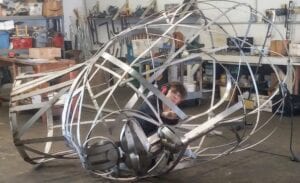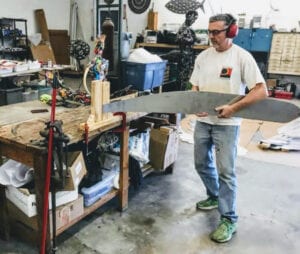
Practical Considerations for Creating Sculpture
How does an artist begin to create a sculpture? Where does one start? It can be daunting to confront a blank canvas, and even more so, a mute block of stone or pile of heavy steel. Your idea is bursting out waiting to be realized. Wait no longer, the following is a nuts and bolts guide to help you zero in on how to proceed with the fabrication of a 3D work of art.
Preliminary considerations
What will your artwork/sculpture look like?
This is quite obvious and usually implicit when you come up with the idea. It helps to take a few days to think about your concept, live with it, let it steep. If the idea continues to compel you, it’s time to proceed.
What type of materials will you use to build your sculpture? Wood, metal, clay, stone, paper mache, or an assemblage of materials?
There is no limit to what can be used to create sculpture. Ever since Duchamp stuck a bicycle wheel on top of a stool and coined the term, readymade, the world of objects has become the sculptor’s oyster. Anything goes. Trash, stones, sand, ice, pots and pans (my specialty), leaves, bones, and living bodies, you name it, the sculptors raw material is only limited by imagination.
Will you employ an additive or subtractive construction technique?
Simply put, the subtractive method removes material to reveal the shape hiding within, like stone and wood carving. Additive methods include building up a form with bits of clay, welding pieces of metal together, and assemblage. A combination of both can also be used, like working in plaster.

What methods will you use to join the materials together?
Glue, welding, solder, screws, hot glue? This brings up the subject of permanence – how long will the sculpture last? Things that live outdoors require maintenance, including houses, buildings, cars, roads, bridges, and sculpture. If your piece lives indoors it will have a much easier life. Even so, nobody wants their art to fall apart. Use the most permanent joining method possible, screws over nails, welding over solder, and if you’re a stone carver, ignore all this.
What textures, colors, and surface treatments will you use?
This is an important consideration. The metallic surface of steel looks much different than a painted surface. The same is true for wood and almost any material. Different grinding effects and patination are also options. You must also consider the protective quality of various finishes and how they will help preserve the work.
Will the form of your sculpture incorporate kinetic elements?
Kinetic sculpture involves engineering, and the more complex the movement the more intensive the engineering becomes. If you have a mechanical inclination then figuring out how your sculpture moves will be right in your wheelhouse.
How will positive and negative space affect the composition?
This question has almost become a cliche, but nonetheless it is still an important design factor to consider. Some designs can be defined by the negative space between the elements. I find the “holes” in a sculpture can add quite a lot of visual interest
How will the viewer interact with the sculpture?
This pertains more to public sculpture where people are going to interact with the work both in positive designed ways, and on the other hand, in negative and potentially hazardous ways. More often, consider how viewers will view and pose for photos with your work.
What size will your sculpture be and how much will it weigh?
Don’t forget you’ll have to move the piece out of the studio eventually, and sculpture has a way of becoming bigger and heavier than expected. If you have an enormous sculpture and don’t have access to a forklift or overhead hoist you may want to consider befriending some powerlifters at your local gym.
Will it be safe? Do you need structural engineering analysis?
Professional engineering is de rigueur when doing public sculpture. More often one uses experience and common sense to figure out what will resist gravity and be possible to build.
How will your sculpture be supported? A base, pedestal, wall hung, or freestanding? How and where will it be displayed?
This is fairly obvious, the base or hanging support should ideally be considered when doing the initial design. Knowing whether the piece will be displayed indoors or out dictates many aspects of how you will construct it for maximum durability.
How will you fund the costs associated with creating the sculpture?
Perhaps this should be your first consideration. With the cost of metals at a new high and lumber skyrocketing, prices of basic materials that were formerly considered to be minimal are now considerable. Usually one has to pay the costs of creating a sculpture themselves unless you are fortunate enough to secure a grant, commission, or private patron. It’s always preferable to use OPM to finance your work, Other Peoples Money.

Will you work alone or will you require help?
Gialanella’s law- the older you get, the more help you’ll need. Artists and especially sculptors are independent, do-it-yourself kind of people. It took me several decades, but I finally learned that a team can get things done that an individual can’t.
Where will you be building the sculpture?
The garage? The patio? The dining room? Not everyone has the luxury of a dedicated studio to work in. The more ambitious your idea, the better equipped space you’ll need to realize it.
Additional tips
Do research to draw inspiration from various reference sources.
Make drawings and a model if necessary.
Research techniques and processes that are new to you, consult with people who have experience in those areas.
Make a production plan list that includes tools, materials, and a timeline. A hard deadline can be a great motivator.
Break down the project into clearly defined phases.


